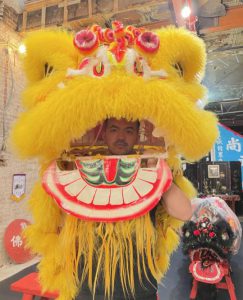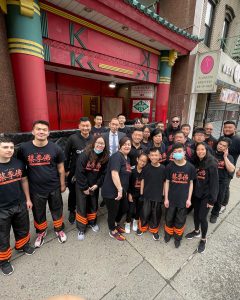
Cody Ng, a seventh grade Social Studies teacher at Sand Creek Middle School, has made a wonderful impact not only on Sand Creek’s students, but also plans to make a larger impact on its AAPI community (Asian American and Pacific Islander). Using his own experiences growing up, he is dedicated to increasing the diversity of our overall school community.
Although not originally from the Albany area, Cody Ng grew up in the Lower East Side of Manhattan, where in 2015 he relocated to Albany to attend the University at Albany for his B.A. in History and Anthropology, his Masters in Anthropology, and his Masters in Secondary Education. Being the first member of his family to graduate from college and being the first in his family to receive a Master’s degree, is a feat that he claims is a major accomplishment.

Since he has joined the South Colonie community, Ng has been making strides to encourage and improve his school’s diversity. During the month of May, which is also Asian American and Pacific Islander Heritage month. Ng wanted to share with his South Colonie family an event that holds an important significance to him, which was New York City’s first AAPI parade. His family, and his family’s traditional Chinese Lion Dance team Choy Lay Fut, were invited to be a part of the parade and also perform and be a part of New York City Mayor Eric Adam’s parade float. Ng described it as being an honor to be able to attend and perform in the first AAPI parade, “all I felt as the hundreds of bystanders clapping and cheering us as we moved through the street, was feeling accomplished, recognized and proud that not only was I being recognized, but the community was being highlighted and celebrated as a whole.”
What is Chinese Lion Dance?
Chinese Lion Dance is a form of traditional dance in Chinese culture, along with other Asian countries where performers wear intricate costumes and imitate the movement of a lion, as well as depict different forms and stances of kung fu (Chinese martial arts).
The Lion dance symbolizes power, wealth, and fortune and is traditionally performed in Chinese festivals and special occasions to bring good fortune and chase away evil spirits, such as in the Chinese or Lunar New Year.
Why is Chinese Lion Dance important to you?
Chinese lion dance is important to me because it has deep roots in my family’s history. Back in the 50’s, my grandfather immigrated from China to the United States where he established his own martial arts school and lion dance group. Since then it has been passed down in my family from generation to generation, where each generation learns kung fu and also learn how to perform the lion dance. My family learned the martial arts form Choy Lay Fut, which is a Chinese martial arts form, and wushu style created in 1836. My ancestors also implemented Choy Lay Fut in their own version of the lion dance.
Lion dance is my way of practicing and ensuring my family traditions stay alive despite the fact that it has changed over time, has gone through many different iterations, not to mention different countries. It allows me to show pride in my family and connect with them.
How does this connect back to the South Colonie’s community?
This is my story and my version of belonging to the AAPI community, this might not resonate with others in the community, but it is my hope that people who read this are able to resonate and connect with my own experiences no matter what tradition they might follow or the type of lifestyles that they have. Through this story, I hope to connect with, not just my students but my potential future students, staff or even graduated alumni, and have people understand that they are represented in South Colonie’s community. That no matter where they came from, what language they speak, what traditions they follow — that there is going to be someone who is able to understand them and connect with them.
It is also my hope that not just members of the AAPI community will be able to connect and understand my background and history, but use this as an opportunity to connect with and understand their classmates, friends, teachers, and neighbors, as we are all a part of the same community and we are all members of South Colonie.
